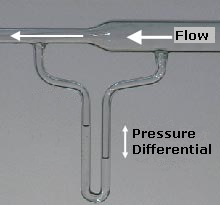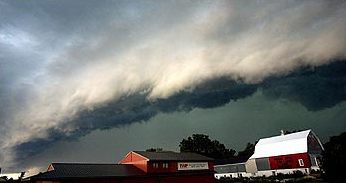|
Balanced Flow
In atmospheric science, balanced flow is an idealisation of atmospheric motion. The idealisation consists in considering the behaviour of one isolated parcel of air having constant density, its motion on a horizontal plane subject to selected forces acting on it and, finally, steady-state conditions. Balanced flow is often an accurate approximation of the actual flow, and is useful in improving the qualitative understanding and interpretation of atmospheric motion. In particular, the balanced-flow speeds can be used as estimates of the wind speed for particular arrangements of the atmospheric pressure on Earth's surface. The momentum equations in natural coordinates Trajectories The momentum equations are written primarily for the generic trajectory of a packet of flow travelling on a horizontal plane and taken at a certain elapsed time called ''t''. The position of the packet is defined by the distance on the trajectory ''s''=''s''(''t'') which it has travelled by time ''t'' ... [...More Info...] [...Related Items...] OR: [Wikipedia] [Google] [Baidu] |
Atmospheric Science
Atmospheric science is the study of the Atmosphere of Earth, Earth's atmosphere and its various inner-working physical processes. Meteorology includes atmospheric chemistry and atmospheric physics with a major focus on weather forecasting. Climatology is the study of atmospheric conditions over timescales longer than those of weather, weather, focusing on average climate conditions and their climate variability and change, variability over time. Aeronomy is the study of the upper layers of the atmosphere, where dissociation (chemistry), dissociation and ionization are important. Atmospheric science has been extended to the field of planetary science and the study of the atmospheres of the planets and natural satellites of the Solar System. Experimental instruments used in atmospheric science include satellites, rocketsondes, radiosondes, weather balloons, radars, and lasers. The term aerology (from Ancient Greek, Greek ἀήρ, ''aēr'', "air"; and -λογία, ''-logy, -logia'' ... [...More Info...] [...Related Items...] OR: [Wikipedia] [Google] [Baidu] |
Density Of Air
The density of air or atmospheric density, denoted '' ρ'', is the mass per unit volume of Earth's atmosphere at a given point and time. Air density, like air pressure, decreases with increasing altitude. It also changes with variations in atmospheric pressure, temperature, and humidity. According to the ISO International Standard Atmosphere (ISA), the standard sea level density of air at 101.325 kPa (abs) and is . At the non-standard sea level temperature of , the density would decrease to . This is about that of water with a density of about . Air density is a property used in many branches of science, engineering, and industry, including aeronautics;Olson, Wayne M. (2000) AFFTC-TIH-99-01, Aircraft Performance FlightICAO, Manual of the ICAO Standard Atmosphere (extended to 80 kilometres (262 500 feet)), Doc 7488-CD, Third Edition, 1993, .Grigorie, T.L., Dinca, L., Corcau J-I. and Grigorie, O. (2010) Aircraft's Altitude Measurement Using Pressure Information:Barometric Altitud ... [...More Info...] [...Related Items...] OR: [Wikipedia] [Google] [Baidu] |
Extratropical Cyclone
Extratropical cyclones, sometimes called mid-latitude cyclones or wave cyclones, are low-pressure areas which, along with the anticyclones of high-pressure areas, drive the weather over much of the Earth. Extratropical cyclones are capable of producing anything from cloudiness and mild rain, showers to severe hail, thunderstorms, blizzards, and tornadoes. These types of cyclones are defined as Synoptic scale meteorology, large scale (synoptic) Low-pressure area, low pressure weather systems that occur in the middle latitudes of the Earth. In contrast with tropical cyclones, extratropical cyclones produce rapid changes in temperature and dew point along broad lines, called weather fronts, about the center of the cyclone. Terminology The term "cyclone" applies to numerous types of low pressure areas, one of which is the extratropical cyclone. The descriptor ''extratropical'' signifies that this type of cyclone generally occurs outside the tropics and in the middle latitudes of Ea ... [...More Info...] [...Related Items...] OR: [Wikipedia] [Google] [Baidu] |
Planetary Boundary Layer
In meteorology, the planetary boundary layer (PBL), also known as the atmospheric boundary layer (ABL) or peplosphere, is the lowest part of the atmosphere and its behaviour is directly influenced by its contact with a planetary surface. On Earth it usually responds to changes in surface radiative forcing in an hour or less. In this layer physical quantities such as flow velocity, temperature, and moisture display rapid fluctuations (turbulence) and vertical mixing is strong. Above the PBL is the "free atmosphere", where the wind is approximately geostrophic wind, geostrophic (parallel to the isobars), while within the PBL the wind is affected by surface Drag (physics), drag and turns across the Contour line#Barometric pressure, isobars (see Ekman layer for more detail). Cause of surface wind gradient Typically, due to aerodynamic drag (force), drag, there is a wind gradient in the wind flow ~100 meters above the Earth's surface—the surface layer of the planetary boundary ... [...More Info...] [...Related Items...] OR: [Wikipedia] [Google] [Baidu] |
Bernoulli's Principle
Bernoulli's principle is a key concept in fluid dynamics that relates pressure, speed and height. For example, for a fluid flowing horizontally Bernoulli's principle states that an increase in the speed occurs simultaneously with a decrease in static pressure, pressure The principle is named after the Swiss mathematician and physicist Daniel Bernoulli, who published it in his book ''Hydrodynamica'' in 1738. Although Bernoulli deduced that pressure decreases when the flow speed increases, it was Leonhard Euler in 1752 who derived Bernoulli's equation in its usual form. Bernoulli's principle can be derived from the principle of conservation of energy. This states that, in a steady flow, the sum of all forms of energy in a fluid is the same at all points that are free of viscous forces. This requires that the sum of kinetic energy, potential energy and internal energy remains constant. Thus an increase in the speed of the fluid—implying an increase in its kinetic energy—occur ... [...More Info...] [...Related Items...] OR: [Wikipedia] [Google] [Baidu] |
Specific Weight
Specific may refer to: * Specificity (other) * Specific, a cure or therapy for a specific illness Law * Specific deterrence, focussed on an individual * Specific finding, intermediate verdict used by a jury in determining the final verdict * Specific jurisdiction over an out-of-state party, specific to cases that have a substantial connection to the party's in-state activity * Order of specific performance, court order to perform a specific act Economics, finance, and accounting * Asset specificity, the extent to which the investments made to support a particular transaction have a higher value to that transaction than they would have if they were redeployed for any other purpose * Specific identification (inventories), summing purchase costs of all inventory items * Specific rate duty, duty paid at a specific amount per unit * Specific risk, risk that affects a very small number of assets Psychology * Domain specificity, theory that many aspects of cogn ... [...More Info...] [...Related Items...] OR: [Wikipedia] [Google] [Baidu] |
Surface Weather Analysis
Surface weather analysis is a special type of weather map that provides a view of weather elements over a geographical area at a specified time based on information from ground-based weather stations. Weather maps are created by plotting or tracing the values of relevant quantities such as sea level pressure, temperature, and cloud cover onto a geographical map to help find synoptic scale features such as weather fronts. The first weather maps in the 19th century were drawn well after the fact to help devise a theory on storm systems.Eric R. MillerAmerican Pioneers in Meteorology.Retrieved on 2007-04-18. After the advent of the telegraph, simultaneous surface weather observations became possible for the first time, and beginning in the late 1840s, the Smithsonian Institution became the first organization to draw real-time surface analyses. Use of surface analyses began first in the United States, spreading worldwide during the 1870s. Use of the Norwegian cyclone model for fronta ... [...More Info...] [...Related Items...] OR: [Wikipedia] [Google] [Baidu] |
Barometer
A barometer is a scientific instrument that is used to measure air pressure in a certain environment. Pressure tendency can forecast short term changes in the weather. Many measurements of air pressure are used within surface weather analysis to help find surface Trough (meteorology), troughs, pressure systems and weather front, frontal boundaries. Barometers and pressure altimeters (the most basic and common type of altimeter) are essentially the same instrument, but used for different purposes. An altimeter is intended to be used at different levels matching the corresponding atmospheric pressure to the altitude, while a barometer is kept at the same level and measures subtle pressure changes caused by weather and elements of weather. The average atmospheric pressure on the Earth's surface varies between 940 and 1040 hPa (mbar). The average atmospheric pressure at sea level is 1013 hPa (mbar). Etymology The word ''wikt:barometer, barometer'' is derived from the Ancient Gr ... [...More Info...] [...Related Items...] OR: [Wikipedia] [Google] [Baidu] |
Ekman Layer
Ekman transport is part of Ekman motion theory, first investigated in 1902 by Vagn Walfrid Ekman. Winds are the main source of energy for ocean circulation, and Ekman transport is a component of wind-driven ocean current. Ekman transport occurs when ocean surface waters are influenced by the friction force acting on them via the wind. As the wind blows it casts a friction force on the ocean surface that drags the upper 10-100m of the water column with it. However, due to the influence of the Coriolis effect, as the ocean water moves it is subject to a force at a 90° angle from the direction of motion causing the water to move at an angle to the wind direction. The direction of transport is dependent on the hemisphere: in the northern hemisphere, transport veers clockwise from wind direction, while in the southern hemisphere it veers anticlockwise.Colling, pp 42-44 This phenomenon was first noted by Fridtjof Nansen, who recorded that ice transport appeared to occur at an angle ... [...More Info...] [...Related Items...] OR: [Wikipedia] [Google] [Baidu] |
Gradient Flow
In vector calculus and physics, a vector field is an assignment of a vector to each point in a space, most commonly Euclidean space \mathbb^n. A vector field on a plane can be visualized as a collection of arrows with given magnitudes and directions, each attached to a point on the plane. Vector fields are often used to model, for example, the speed and direction of a moving fluid throughout three dimensional space, such as the wind, or the strength and direction of some force, such as the magnetic or gravitational force, as it changes from one point to another point. The elements of differential and integral calculus extend naturally to vector fields. When a vector field represents force, the line integral of a vector field represents the work done by a force moving along a path, and under this interpretation conservation of energy is exhibited as a special case of the fundamental theorem of calculus. Vector fields can usefully be thought of as representing the velocity of ... [...More Info...] [...Related Items...] OR: [Wikipedia] [Google] [Baidu] |
Inertial Flow
In atmospheric science, balanced flow is an idealisation of atmospheric motion. The idealisation consists in considering the behaviour of one isolated parcel of air having constant density, its motion on a horizontal plane subject to selected forces acting on it and, finally, steady-state conditions. Balanced flow is often an accurate approximation of the actual flow, and is useful in improving the qualitative understanding and interpretation of atmospheric motion. In particular, the balanced-flow speeds can be used as estimates of the wind speed for particular arrangements of the atmospheric pressure on Earth's surface. The momentum equations in natural coordinates Trajectories The momentum equations are written primarily for the generic trajectory of a packet of flow travelling on a horizontal plane and taken at a certain elapsed time called ''t''. The position of the packet is defined by the distance on the trajectory ''s''=''s''(''t'') which it has travelled by time ''t'' ... [...More Info...] [...Related Items...] OR: [Wikipedia] [Google] [Baidu] |





